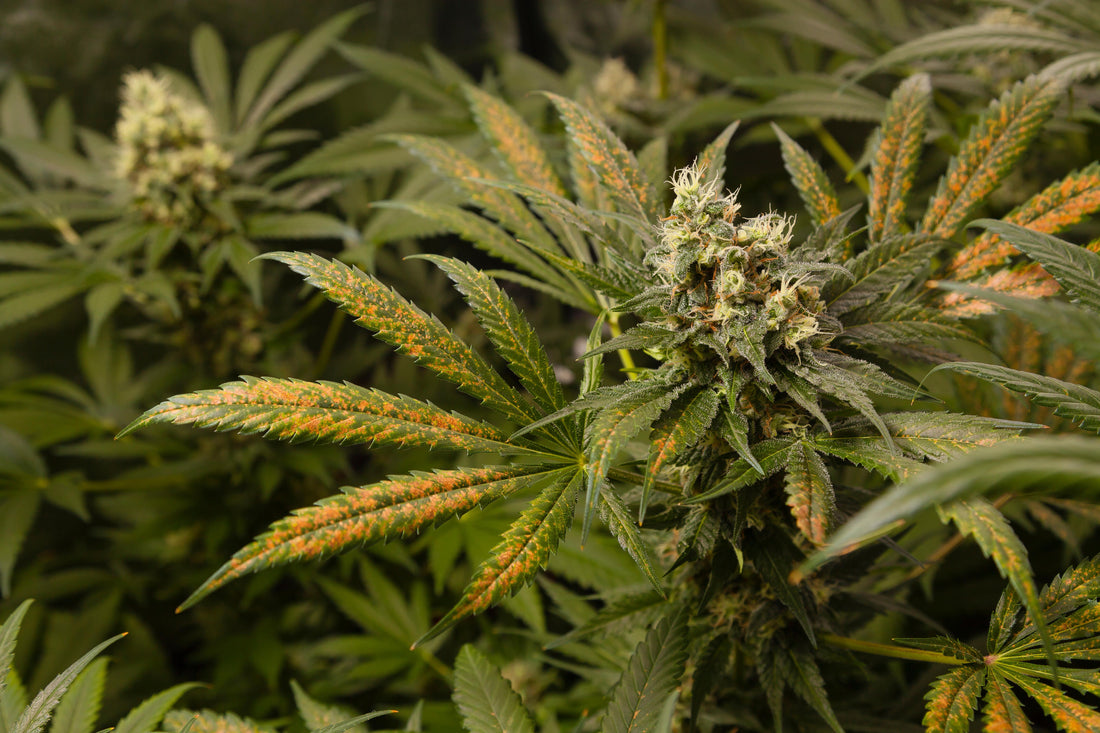
Diseases Affecting Cannabis Propagation and Prevention Solution
As a content and community manager, I leverage my expertise in plant biotechnology, passion for tissue culture, and writing skills to create compelling articles, simplifying intricate scientific concepts, and address your inquiries. As a dedicated science communicator, I strive to spark curiosity and foster a love for science in my audience.


Cannabis is affected by several microorganisms belonging to the category of viruses, bacteria, and fungus. And, of all the mentioned microbes/organisms, it’s fungi, followed by viroids and viruses that infect the plant the most.
Introduction
For many years, Cannabis has been used by people for its applications in food, medicine, oil, textile fiber, etc. Mainly, this plant has been known because of its medicinal properties and its ability to treat diseases like asthma, epilepsy, fatigue, glaucoma, pain, and rheumatism. Some of its derivatives have been found to help in multiple sclerosis and HIV/AIDS.
Cannabis sativa is also known as hemp or marijuana and is a member of the family Cannabaceae. It contains a number of secondary metabolites that have several applications in human life, especially for medicinal purposes. Some of the major cannabinoids of the plant are THC, CBD, THCV, CBC, CBG, and CBN.
For its applications, it has occupied become one of the fastest emerging markets worldwide. But, its large-scale cultivation is a challenge that mainly includes infection outbreaks of pests and microbial infections, transportations challenges, and uniformity between the Cannabis crops
This article covers a review of the microbes that are a serious threat to the plant in both, in vitro and ex vitro conditions.
Diseases of Cannabis

Cannabis is affected by several microorganisms belonging to the category of viruses, bacteria, and fungus. And, of all the mentioned microbes/organisms, it’s fungi, followed by viroids and viruses that infect the plant the most. The diseases are also categorized based on the tissue they infect, which include root and crown infecting, foliar and stem-infecting, inflorescence-infecting, and postharvest pathogens. The diseases cause farmers and culturists to lose their effort, money, and time.
Bacterial Diseases
Some bacteria causing infecting Cannabis plants include Pseudomonas syringae and Xanthomonas campestris pv. Cannabis. The symptoms of Pseudomonas syringae are small water-soaked leaf spots that may enlarge along the veins, turning brown. The Xanthomonas campestris causes leaf spots and wilting in plants.
Fungal Diseases
Some of the major cannabis infecting fungus and diseases caused by them are:
- Fusarium oxysporum f.sp. Cannabis causes wilt whose symptoms include yellowing of leaves, poor growth, and wilt.
- Pythium disease causes root rot and damping-off disease whose symptoms vary from small roots lesions, severe root damage, stunted growth, to yellowing of leaves. Further, damping-off affects young seedlings.
- Sclerotinia sclerotiorum causes hemp canker whose initial symptoms include watersoaked lesions on stalks and branches that can later cause cankers. Sometimes cottony white mycelium and black sclerotia may also appear.
- Sphaeorotheca macularis or Leveillula taurica causes powdery mildew. It’s one of the most common foliar diseases of cannabis. Its symptoms include powdery growth on the surface of leaves that later turns brown.
- The cannabis plant is also affected by Alternaria species, which causes leaf spot and brown blight diseases.
Viral and Viroid Diseases
Viruses affecting cannabis include Hop mosaic virus (HpMV), Apple mosaic virus (ApMV), Hop stunt viroid (HSVd), Hop latent viroid, Arabis mosaic virus (ArMV), Alfalfa mosaic virus (AMV), Tobacco mosaic virus (TMC), Cucumber mosaic virus (CMV), and phytoplasmas.
The viruses can cause severe crop losses, reduce growth, or affect the yield and quality of crops. The common symptoms of viruses include yellow and green mosaic patterns on the leaves of Cannabis and curling, distortion, and narrowing of young leaves. Phytoplasmas mainly cause severe shoot proliferation and stunted growth.
The hop latent viroids have mainly been found to affect cannabis in California, other areas of the USA, and Canada. Its symptoms include stretched and horizontal plant growth, brittle stems, malformed or chlorotic leaves, stunting, and small and malformed flowers.
The viruses spread and invade other plants through infected mother plants, cuttings, and, potentially seeds. And, HpLVD can spread by using contaminated tools, equipment, our hands, and the clothing of people working in labs.
Pathogen Identification Methods
- The identification of fungi and oomycetes can be first done at the genus level by identifying the morphological characteristics/features. This can be followed by species identification using molecular methods, which include polymerase chain reaction (PCR) of the ribosomal DNA region that includes the internal transcribed spacer (ITS) and intergeneric spacer regions (IGS).
- Bacterial pathogens can be identified based on PCR methods that utilize the 16S region of ribosomal RNA (rRNA).
- Viruses and viroids can be identified by molecular analysis that involves RT-PCR of RNA templates and next-generation sequencing (NGS).
Some Control Measures For Cannabis Diseases

Cannabis diseases can be controlled by disruption of the disease cycle, which includes prevention of inoculum introduction, preventing infection or symptom development, reducing secondary inoculum production and spread, and reducing survival of the pathogen. Given below are some approaches to use in the prevention of cannabis diseases:
- Maintain complete cleanliness and sanitary conditions in cannabis-growing facilities.
- Use air purification systems such as HEPA filters and UV to reduce airborne contaminants and pathogens.
- Clean and sanitize tools, equipment, dehumidifiers, air filters, and growing and trimming rooms.
- Minimize the attack of Botrytis by maintaining appropriate humidity, air temperature, better air circulation, and clean and sterilized drying areas.
- Root rot, crown rot, and damping-off can be avoided by treating irrigation water using UV, chlorine, or other registered products.
- For the culturing process, use disease-free stock or cuttings from healthy mother plants. So, one must ensure that the plant material entering the facility are inspected and quarantined for disease symptoms.
- To get rid of Hop Latent Viroids it’s recommended to ensure that the stock plants are disease-free and remove or destroy any infected plants.
How Tissue Culture Helps Produce Disease-Free Cannabis Plants?

Tissue culture is a powerful technique for producing disease-free cannabis plants through a series of controlled and sterile processes. Here's how tissue culture helps in achieving this:
- Starting with Clean Plant Material: The process begins with the selection of healthy and disease-free plant material, typically small plant parts like meristems or shoot tips. These are carefully collected from cannabis plants that are known to be free from pathogens.
- Surface Sterilization: The collected plant material is then subjected to surface sterilization using a combination of disinfectants, such as bleach and alcohol. This step is crucial for eliminating any external pathogens that might be present on the plant material.
- In Vitro Culture: The sterilized plant material is placed in a sterile nutrient-rich agar medium in a controlled environment, such as a culture vessel or flask. This environment is designed to promote growth while preventing contamination.
- Isolation: The culture vessels are sealed or covered to isolate the plant material from the external environment. This isolation is essential to ensure that no pathogens can enter the culture during the growth phase.
- Regular Monitoring: The tissue-cultured plants are closely monitored for signs of contamination or disease. If any issues arise, they can be addressed promptly, often by removing the affected plant material.
- Subculturing: As the tissue-cultured plants grow, they are periodically subcultured into fresh growth medium to maintain their health and vigor. This process also helps in ensuring the absence of pathogens.
- Genetic Uniformity: Tissue culture produces genetically identical clones of the original plant. If the parent plant is disease-free, then all the clones will also be disease-free, ensuring uniformity and reliability.
- Pathogen Testing: Before tissue-cultured plants are introduced into commercial production or cultivation, they can undergo rigorous testing for the presence of pathogens. This is an additional layer of assurance to confirm their disease-free status.
- Propagation of Resistant Varieties: If a cannabis variety is known to be resistant to certain diseases, tissue culture can be used to propagate that variety, ensuring that the offspring inherit the same resistance.
How Plant Cell Technology Help Cannabis Culturists to Prevent Viruses From Affecting Their Cultures?

Plant Cell Technology is helping culturists for more than two decades in their tissue culture procedures. It provides tools, equipment, and solutions at all levels of the process.
Plant Cell Technology provides consultation services to tissue culturists around the world where they get the chance to directly talk with our scientists and get instant solutions for their problems.
We have special Cannabis Tissue Culture and Consulting programs for Cannabis culturists. It helps you to optimize your cultivation operations by receiving proprietary, data-proven SOPs, and protocols. The service includes:
- Media Preparation: 2 sets of proprietary media preparation SOP's (4 in vitro shoot multiplication protocols and 5 in vitro rooting protocols along with coaching on how to conduct factorial trials).
- Micropropagation: You learn how to select, surface sterilize, and induce nodes into media for the removal of surface pathogens and in vitro cloning applications.
- Meristem Dissection: Get an understanding of how to dissect apical meristem to remove viruses including HpLvd, Cannabis Cryptic Virus, Lettuce Chlorosis Virus, and others.
- Synthetic Seed and Cryopreservation: Learn the long-term genetic storage solutions.
- Pathogen Remediation by Media Amendments: Learn how to remove viruses, systemic fungi, bacterial infections, and endophytes.
- Gender and Pathogen Screening by PCR: Eliminate male plants, identify cannabinoid ratios, and protect your mothers from pathogens and pests.
This is a unique solution that can’t be found anywhere at a very reasonable cost. We ensure you get top-of-the-world experience and answers to all your confusions and queries related to cannabis tissue culture.
Schedule your call now with our scientists and get word-class solutions for your cannabis culture problems.
Happy Culturing!!

Source: Giphy
References
- Punja, Z. K. (2021). Emerging diseases of Cannabis sativa and sustainable management. Pest Management Science, 77(9), 3857–3870. doi:10.1002/ps.6307.
- https://www.plantcelltechnology.com/blog/cannabis-tissue-culture-infection-and-prevention/
- https://www2.gov.bc.ca/assets/gov/farming-natural-resources-and-industry/agriculture-and-seafood/animal-and-crops/plant-health/diseases_of_cannabis_in_british_columbia.pdf
- https://allcropsolutions.com/disease-testing/hemp-...
- https://agri.nv.gov/uploadedFiles/agrinvgov/Conten...
Blog Categories
View by Level
Popular Blogs

New Technical Agar Vs Supreme Agar
Introduction What’s the secret element that supports and holds plants in vitro? Not sure? It’s the solidifying agent. Solidifying agents...
Read More
Get the Protocol: How to Tissue Culture Nepenthes Using Nodes and Seeds
Introduction This plant is non-vegeterian... ...and we're not kidding! Nepenthes belongs to one of the most interesting families of carnivorous...
Read MoreSubscribe to Our Newsletter








Join the conversation
Your email address will not be published. Required fields are marked